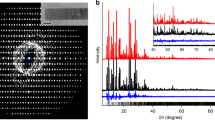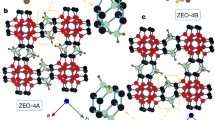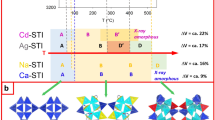Abstract
INORGANIC microporous framework solids such as zeolites are of considerable technological importance as shape-selective catalysts, ion-exchange materials and molecular sieves1. Most microporous materials known until recently were silicates, aluminosilicates1 or aluminophosphates2–4, all of which contain tetrahedrally coordinated metal atoms. In 1989, a family of microporous titanosilicates (generically denoted ETS) was discovered in which the metal atoms (Ti4+) are octahedrally coordinated5–8. A full understanding of the potential of any microporous solid to act as a molecular sieve and selective catalyst, and of the nature of the catalytic centres, requires that its structure be known. But that of the ETS materials has proved elusive because of the considerable degree of disorder that they contain. Using a combination of high-resolution electron microscopy, electron and powder X-ray diffraction, solid-state NMR, molecular modelling and chemical analysis, we have now been able to solve the structure of a prominent member of this family, ETS-10. This structure comprises corner-sharing SiO4 tetrahedra and TiO6 octahedra linked through bridging oxygen atoms. The pore system contains 12-membered rings and displays a considerable degree of disorder. Many ordered variants of ETS-10 exist, some of which are chiral.
This is a preview of subscription content, access via your institution
Access options
Subscribe to this journal
Receive 51 print issues and online access
$199.00 per year
only $3.90 per issue
Buy this article
- Purchase on Springer Link
- Instant access to full article PDF
Prices may be subject to local taxes which are calculated during checkout
Similar content being viewed by others
References
Breck, D. W. Zeolite Molecular Sieves (Wiley, New York 1974).
Wilson, S. T., Oak, S., Lok, B. M., Flanigen, E. M. & Plains, W. US Patent No 4310440 (1982).
Lok, B. M., Messina, C. A., Gajek, R. T., Cannan, T. R. & Flanigen, E. M. US Patent No. 4440871 (1984).
Wilson, S. T., Oak, S. & Flanigen, E. M. US Patent No. 4567029 (1986).
Kuznicki, S. M. US Patent No. 4853202 (1989).
Kuznicki, S. M. & Thrush, A. K. European Patent No. 0405978A1 (1990).
Chapman, D. M. & Roe, A. L. Zeolites 10, 730–737 (1990).
Haushalter, R. C. & Mundi, L. A. Chem. Mater. 4, 31–48 (1992).
Taramasso, M., Perego, G. & Notari, B. US Patent No. 4410501 (1983).
Wadlinger, R. L., Kerr, G. T. & Rosinski, E. J. US Patent No. 3308069 (1967).
Newsam, J. M., Treacy, M. M. J., Koetsier, W. T. & de Gruyter, C. B. Proc. R. Lond. A420, 375–405 (1988).
Treacy, M. M. J., Newsam, J. M. & Deem, M. W. Proc. R. Soc. A433, 499–520 (1991).
Author information
Authors and Affiliations
Rights and permissions
About this article
Cite this article
Anderson, M., Terasaki, O., Ohsuna, T. et al. Structure of the microporous titanosilicate ETS-10. Nature 367, 347–351 (1994). https://doi.org/10.1038/367347a0
Received:
Accepted:
Issue Date:
DOI: https://doi.org/10.1038/367347a0
This article is cited by
-
Enhanced removal of rare earth elements from aqueous media: exploring the potential of AM-3 and AM-4 titanosilicates
Environmental Science and Pollution Research (2024)
-
Cerium-ion-exchanged copper silicate: for catalytic methanol dehydrogenation
Journal of Chemical Sciences (2022)
-
A zeolitic vanadotungstate family with structural diversity and ultrahigh porosity for catalysis
Nature Communications (2018)
-
The role of carbon nanotubes and cobalt in the synthesis of pellets of titanium silicates
Journal of Porous Materials (2018)
-
A Novel Zeotype Vanadoarsenate [NH4VO(AsO4)]n with ETS-10-like Topological Framework
Journal of Cluster Science (2018)
Comments
By submitting a comment you agree to abide by our Terms and Community Guidelines. If you find something abusive or that does not comply with our terms or guidelines please flag it as inappropriate.



